A bishop is an ordained member of the clergy who is entrusted with a position of authority and oversight in a religious institution. In Christianity, bishops are normally responsible for the governance and administration of dioceses. The role or office of the bishop is called episcopacy. Organizationally, several Christian denominations utilize ecclesiastical structures that call for the position of bishops, while other denominations have dispensed with this office, seeing it as a symbol of power. Bishops have also exercised political authority within their dioceses.

Barnabas, born Joseph (Ἰωσήφ) or Joses (Ἰωσής), was according to tradition an early Christian, one of the prominent Christian disciples in Jerusalem. According to Acts 4:36, Barnabas was a Cypriot Jew. Named an apostle in Acts 14:14, he and Paul the Apostle undertook missionary journeys together and defended Gentile converts against the Judaizers. They traveled together making more converts, and participated in the Council of Jerusalem. Barnabas and Paul successfully evangelized among the "God-fearing" Gentiles who attended synagogues in various Hellenized cities of Anatolia.

An episcopal polity is a hierarchical form of church governance in which the chief local authorities are called bishops. The word "bishop" here is derived via the British Latin and Vulgar Latin term *ebiscopus/*biscopus, from the Ancient Greek ἐπίσκοπος epískopos meaning "overseer". It is the structure used by many of the major Christian Churches and denominations, such as the Catholic, Eastern Orthodox, Oriental Orthodox, Church of the East, Anglican, Lutheran and Methodist churches or denominations, and other churches founded independently from these lineages.
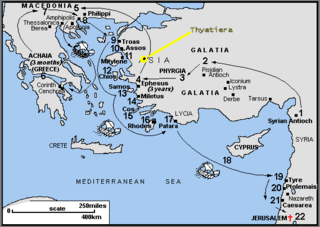
Thyateira was the name of an ancient Greek city in Asia Minor, now the modern Turkish city of Akhisar, Manisa Province. The name is probably Lydian. It lies in the far west of Turkey, south of Istanbul and almost due east of Athens. It is about 50 miles (80 km) from the Aegean Sea.
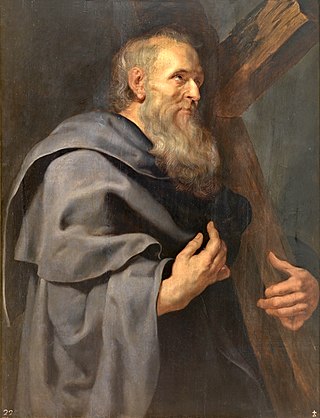
Philip the Apostle was one of the Twelve Apostles of Jesus according to the New Testament. Later Christian traditions describe Philip as the apostle who preached in Greece, Syria, and Asia-Minor.
Irenopolis or Eirenoupolis was an ancient and medieval city in Roman and Byzantine era Isauria.

Lydia of Thyatira is a woman mentioned in the New Testament who is regarded as the first documented convert to Christianity in Europe. Several Christian denominations have designated her a saint.
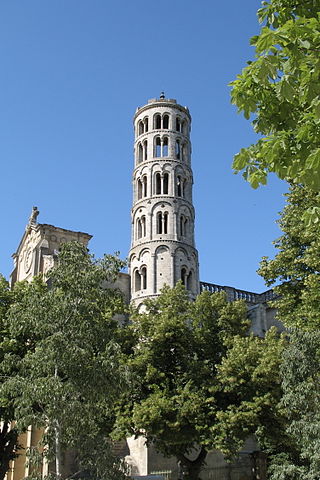
The Ancient Diocese of Uzès is a former Roman Catholic diocese in France. From the arrival of Christianity in the 5th century until the French Revolution the southern French city of Uzès was the seat of a bishop, a competitor to the local lords.

The Archdiocese of Athens is a Latin Church ecclesiastical territory or archdiocese of the Catholic Church in Greece. Its cathedra is found within the neoclassic Cathedral Basilica of St. Dionysius the Areopagite, in the episcopal see of Athens.

Abonoteichos, later Ionopolis, was an ancient city in Asia Minor, on the site of modern İnebolu, and remains a Latin Catholic titular see.
Early Christianity, otherwise called the Early Church or Paleo-Christianity, describes the historical era of the Christian religion up to the First Council of Nicaea in 325. Christianity spread from the Levant, across the Roman Empire, and beyond. Originally, this progression was closely connected to already established Jewish centers in the Holy Land and the Jewish diaspora throughout the Eastern Mediterranean. The first followers of Christianity were Jews who had converted to the faith, i.e. Jewish Christians. Early Christianity contains the Apostolic Age and is followed by, and substantially overlaps with, the Patristic era.
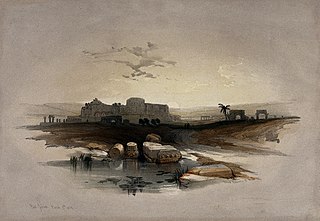
Eleutheropolis in Palaestina is a titular see of the Roman Catholic Church located in modern Israel. The position of bishop is vacant.
The Latin Bishopric of Argos is a former Latin Church episcopal see in the Argolid in southern Greece, formed with the establishment of the Crusader States, and suffragan to the Latin Archbishop of Corinth. For part of its history it totally supplanted the local Greek Orthodox episcopal administration and at other times existed in competition with it. At various times in its history it had no incumbent bishop. It was finally suppressed in 1715 and exists now as a Catholic titular see.

Hyacinthe Serroni was an Italian Roman Catholic bishop, diplomat, and steward of the Navy for the kingdom of France.

Guillaume-Louis du Tillet was a French prelate, last bishop of Orange, and clerical deputy to the States General in 1789.
François-André Roussel de Tilly, from Moulins, who died in 1775, was a French prelate of the 18th century and Bishop of Orange, France.

Pierre-Louis Leysin was a French clergyman who was the 81st and last Archbishop of Embrun from 1767 to 1790. Having refused to take the constitutional oath, he died in exile.
Centuria, also known as Centuriensis, was a Roman era town in Numidia, Roman province of Africa. It has been tentatively identified with ruins near Ain El Hadjar in Algeria, south of Saida.
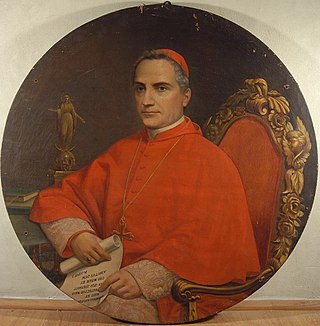
Giacomo Cattani was an Italian Catholic Cardinal and Archbishop.
Mathurin de Savonnières, born in Angers and died in 1586 in Paris, was a French bishop of the sixteenth century. Mathurin was the son of Jean, Lord of Brétèche, and Olive de Mathefelon. His brother Jacques was Abbot of Cadouin and Melleray and his sister Jeanne Abbess of Cordillon.
















